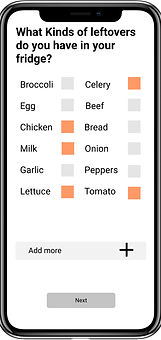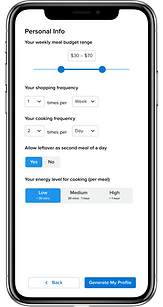FridgeNinja
Application Design

The Problem
People usually face with expire foods in their fridge and have trouble in consuming foods. In this project we aim to figure out how can we help people consume perishable foods in their fridge before they expire and give solutions to reduce food waste due to food decay or expiration.
Our Solution
We decided to use Design Thinking methodology to uncover the pain points and develop a solution for creating a method to help people who have trouble consuming perishable foods in their fridge before they expire.
My Role
UX Designer
-
User research
-
Sketching
-
UI design
-
Prototyping
-
Usability testing
Tools
-
Figma (Screen Design & Prototyping)
-
Miro Board (Sharing Ideas & Collaborating)
-
Pen & Paper (Sketching)
Duration
9 Weeks
Design Thinking Phases
PHASE 1
EMPATHIZE
Interview
Personas
PHASE 2
DEFINE
Affinity Diagramming
Define HMW
PHASE 3
IDEATE
Brainstorming
Mash Ups
PHASE 4
PROTOTYPE
Sketch
Rapid Prototyping
PHASE 5
TEST
Usability Testing
Empathize
We conducted research, interviewed people in order to gather human-centered data, and identified their needs and their main concern.
“I’m too busy and don’t have enough time to cook what I bought”
- A single female with a full-time job
"I do cooking two or three times a week. I usually eat out during the week but I buy lots of fruits or snacks too and keep them in my fridge."
- A couple without kids

Personas

Name: Bethany
Sex: female
Age: 23
Bio
Bethany is a young nurse who recently graduated from university a few months ago, found a job as an RN at a hospital in a neighboring state, and moved into her own apartment. She doesn't know anyone in town, so her primary support system is not present here. She's making new friends, but she doesn't have much time to socialize due to her inconsistent hours.
Goals
-
To spend more time in the kitchen, and have control over her choices for meals
-
To keep better track of her inventory
-
To cook based on what she already has in her fridge
Frustrations
-
Doesn't like to see food being tossed out
-
Feeling guilty when she faces wasteful foods
-
Being too busy and not cooking regularly

Name: Susan
Sex: female
Age: 45
Bio
Susan is a housewife who lives with her husband, and they have an only child who has gone to college now. She has to take care of elderly people. She does housework and cooks three meals every day. Different family tastes often make her feel hard to decide what to cook for each day. She often worries about how to deal with the leftovers.
Goals
-
Something to remind her about leftovers
-
Need to know the direct location of the food in the fridge that will expire soon
Frustrations
-
Susan is forgetful about what food is in her fridge.
-
She usually cannot find the food she wants due to the huge amount of food in the fridge
-
Cook too much and eat a little

Name: Susie
Sex: female
Age: 30
Bio
Susie has been married for 4 years. She and her husband live in a small town in Iowa. They both have a full-time job and they are a busy couple. Susie has a busy schedule without lots of free time. She loves to be active and she prefers to work out as soon as she finds free time.
Goals
-
To do the right amount of grocery shopping and prevent from producing lots of leftovers
-
Help her with choosing what foods to cook based on their loftovers
-
Help her to remember which food will be expiring soon in their fridge
Frustrations
-
Busy schedule and forgets to organize their fridge
-
Tired of feeling bad smell in the fridge because of rotten foods
-
Waste lots of money by buying foods and not consuming them
Define
After interviewing people and doing research, we overwhelmed with lots of information. So, we decided to categorize them based on their similarity to clarify the users' needs and identify the problem. Then, we started to create affinity diagram and how might we questions.
Affinity Diagramming
When we were overwhelmed in huge amount of information, we organized items into logical groups by the help of affinity diagramming. Below are the affinity diagram created in miro board based on the interview results and personas.
Organization Habits
Not clean up my fridge regulary
Doesn't know what foods are in their fridge
Always a small portion of each expires in the fridge
Not checking the expiration date regularly
Eating Habits
Not enough energy to cook every day
Buy too much and eat a little
Have perishable food regularly
I don't like to decide my meals beforehand
Emotions
Feel guilty throwing out food
Key Insights
-
Always have expired food
-
Buy too much and eat a little
-
Not clean up the fridge regularly
-
Blindspot of food
How Might We...?
We started the HMW process by asking several questions and finally we end it up with the following question:
-
How might we help users shop for the appropriate amount of food and suggest recipes based on their lifestyle, energy levels, and leftover food in their fridge?
Ideate
Mash-up and Forced Connections
For the next step, we started brainstorming in order to generate ideas for solving the problem. We used an ideation method called Mash-up and Forced Connections to bring odd or unexpected things together to spark fresh ideas. We developed the two categories including category 1: come up with as many elements of these experiences as possible. Category 2: tangible solutions - product; service; systems. Then we combined (MASH-UP) items from the two different lists to develop new ideas.
Develop the Two Categories
Category 1
(experience)
Creating shopping list based on user's diet
Category 2
(tangible solution- product or service)
Christmas dinner/feast
deciding what to purchase
Presents under the Christmas tree
Checking expiration date of the product during the shopping
Christmas cookies
Create a List of Mash-ups Combining Items from Category 1&2
A feature with lots of recepies for different diets and special recepies
A feature called "Surprise Me" that generate a recipe based on what's left in the fridge (this helps consume leftover with more options)
A system that can record the food expired date by scanning the bar code and giving eating suggestions.
Forced Connections & Sketch
After creating some bright ideas by Mash-up method, we also used forced connections method to narrow down pervious ideas and connect them. Then we started to sketch them in order to build out a simple prototype and make the ideas more clear.





Key Insights
The features that we came up with include:
-
Obtain users' dietary/lifestyle/budget data
-
Recipe recommendation based on user's diet and leftovers in the fridge
-
Generating recipe with some magic based on user's leftover in the fridge
Digital Wirframing
After the ideation phase and making decision about the main features of the application, we converted the ideas into prototypes and tested with real users. At this step, each of the team members create two porotypes based on the results gained from the previous steps.




Prototype








Usability Testing
The final step is testing our prototypes with 4 potential stakeholders. We developed a set of interview questions to prompt their engagement with our solution. For the interview process, we shared the link of the prototype and observed them while they were using the application and tried to find the answer to several questions like:
-
Does the prototype do what it is meant to do?
-
Is the user confused when using the product?
-
Is the user distracted by something when using the product?
-
Is the navigation sensible and intuitive?
-
Do the users feel that the product was developed for them?
We also asked participants some questions like:
-
Could you identify the 2 main features of this app?
-
How would you describe your overall experience with FridgeNinja application?
-
What features do you find most valuable in the application and why?
-
What features do you find not very appealing and why?
-
Do you recommend the FridgeNinja application to your friends/family?
Capturing Feedbacks
Eventually, based on the results of the interview we got some feedbacks including:
-
Making the leftover feature as the main feature because there are currently apps that recommend recipes
-
Navigation is a little bit confusing due to technology problem
-
Add family members and share the info with them
What’s Next?
-
Add a “money saved” feature that shows users how much they save on food by using leftover ingredients
-
Incorporate a social aspect into the app that allows for users to share recipes with one another like their families
-
Incorporate minor design changes such as the color-coding used to indicate which foods are soon-to-be expired, add recipe descriptions, and change the names of food categories
-
Adding an audio feature where users can listen to instructions when cooking instead of reading from the screen
-
Adding instructional cooking videos to help visual learners